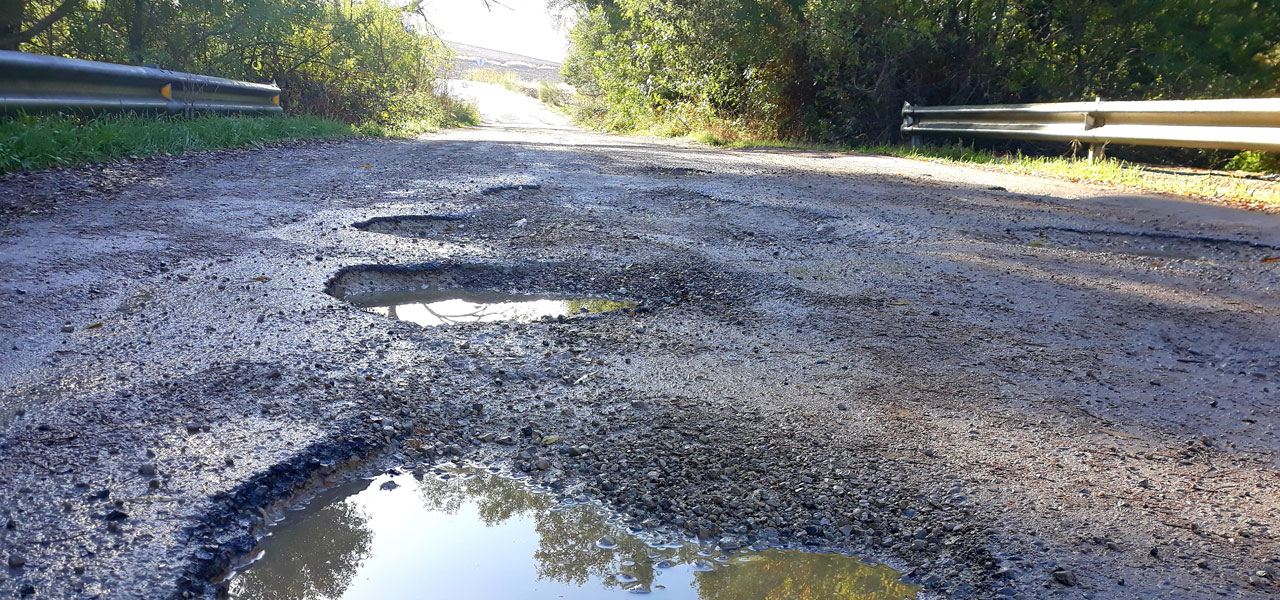Potholes are bad news for vehicle owners. Not only do they damage cars, but they also cause insurance premiums to escalate to cover additional expenses. We look at some common pitfalls of potholes and how clients - especially farmers - can minimise damages and costs.
An increase in motor vehicle claims related to the deterioration of road conditions
If your clients are driving on one of South Africa’s main roads today, chances are pretty good that they will come across a few potholes. Potholes are the result of many factors, including the increased volume of vehicles on our roads, the higher than average seasonal rainfalls, as well as the lack of ongoing maintenance on South Africa’s roads. The bad news for road users is that these potholes invariably lead to vehicle accidents, extensive damage to vehicles and, in some cases, to fatalities.
In the past year, Santam has experienced an increase in motor vehicle claims related to the deterioration of road conditions. Until such time as the condition of roads in South Africa has improved, clients need to be extra cautious about road conditions and surroundings.
How vehicle owners can avoid costs due to potholes
Whether insurance will cover pothole damages depends largely on where a person normally drives in their day-to-day lives. Loss of or damage to a vehicle’s suspension, springs or shock absorbers caused by uneven roads or inequalities in the road is excluded in terms of Santam’s policy wording. If, for example, a person drives every day on a corrugated road which is also riddled with potholes, it can be expected that the vehicle’s shock absorbers will be gradually damaged. Santam will not be liable for the loss or damages in this instance.
However, if road surfaces are normal and a vehicle’s shock absorbers or tyres are damaged by an isolated pothole in the road, the insured should be indemnified, as having been involved in a one-off accidental incident. Damage to the vehicle’s suspension caused by impact from a pothole in the road will, therefore, be approached in the same manner as damage, for example, caused by impact with a curbstone.
Claiming damages against a municipality
If a driver doesn’t have vehicle insurance, they could lodge a civil action against the municipality or body responsible for maintaining the roads. Should the responsible municipality or body fail to assess or to adjudicate the claim, consumers are at liberty to appoint an attorney to institute a formal litigation process against the said parties. For this kind of claim, they need to submit a ten-page document to the Chief Directorate of Roads, detailing information such as the vehicle’s details; a SAPS report; three quotations for repairs to make good the damage, and supporting photographs. Claiming against the responsible municipality, however, is a long and cumbersome process which requires strict compliance with the requirements of the responsible body.
If they’ve been in a motor vehicle accident, they can also claim General Damages (serious injury only), loss of income (limited per annum) and medical expenses from the Road Accident Fund (RAF), but only if the incident was either a hit-and-run or if there was another vehicle involved in the accident. Since no property damage can be claimed from the RAF, consumers involved in accidents caused by potholes cannot, therefore, claim from the RAF.
The best safety net for road users is the one provided by the National Roads Agency – and this applies to the so called “N”-roads such as the N1, N2, N3, N12, etc. If you do hit a pothole, you need to visit your tyre dealer immediately to get the wheel balance and alignment checked. It is also important to ask them to do a visual check under the car to see whether there is additional damage. Not doing so quickly can lead to excessive tyre wear and increased fuel consumption. You can also share more tips with clients on how to protect their vehicles from pothole damage in this article.
Extra protection for farmers: general goods in-transit insurance
Farmers can potentially suffer huge losses due to potholes when their produce is transported. It is recommended that owners of trucks, light delivery vehicles and agricultural trailers include in-transit cover for goods on their policies. This policy can be extended to include theft and hijacking.
A general in-transit policy provides limited or all-risk cover for transporting goods on any medium of transport by road or by rail. Limited cover provides insurance only for damage or loss caused to the load as a result of fire, explosion, a collision, derailment or the overturning of a transport medium. This policy can, however, be extended to include theft, hijacking at an additional premium. Should a vehicle hit a pothole and as a result, the driver loses control and overturns the vehicle, the damaged goods will be covered under Goods in Transit.
Should a farmer’s truck hit a pothole and the farmer’s goods are damaged as a result of the impact caused by the pothole, without an initial accident, the farmer will unfortunately not be covered if the goods were not insured in terms of all risk cover (that would include the collision of the load) under Goods in Transit.
If you like more information about insurance for vehicle owners or agriculture clients, speak to your relationship manager or contact Santam. For more advice tailored to intermediaries, visit our blog where you will find more useful articles, such as how to ensure farmers have sufficient liability insurance.
